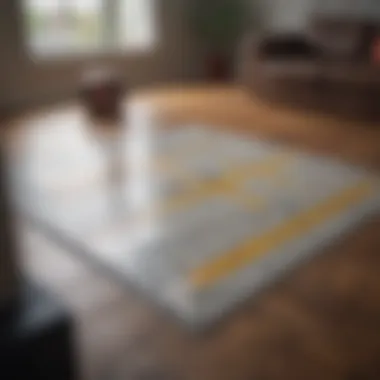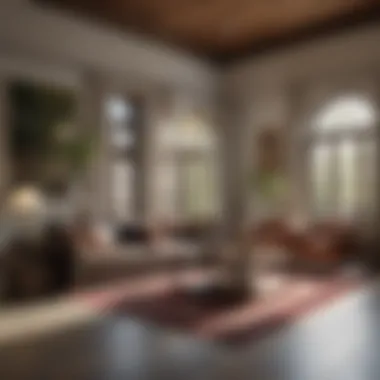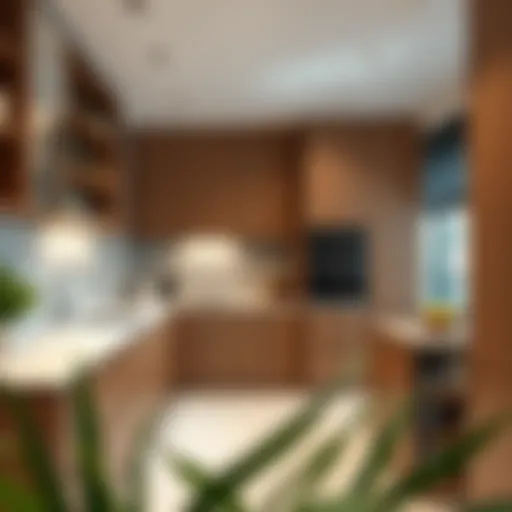Calculating Square Feet: A Complete Guide


Intro
Calculating square feet is more than a mere mathematical exercise; it serves as a fundamental skill within various fields such as real estate, home design, and construction. Understanding how to measure and compute area accurately can notably influence outcomes in pricing, usability, and aesthetic design. For anyone involved in these areas, mastering this skill means standing equipped to tackle complex scenarios more effectively.
This guide aspires to provide insights and practical methods that ensure precision in square footage calculations. Also, we’ll explore various case studies and real-world examples that illustrate the importance of this seemingly straightforward measurement. By breaking it down piece by piece, we will unwrap not just the "how" but also the "why" behind the calculations, fostering a deeper appreciation for the relevance of square footage in both everyday applications and specialized tasks.
In the following sections, we’ll delve into specific aspects of square footage – from foundational concepts informing your measurements to scenarios where precision is crucial.
Featured Homes
Architectural Styles
When calculating square footage, one can’t overlook the role architectural styles play. Each home design brings unique features that impact measurements. For example, an open-concept layout may present fewer interruptions and allow for smoother square footage calculations than a more traditional design, laden with nooks and crannies.
Homes that incorporate sprawling elements like vaulted ceilings or extensive glass walls can also affect perceptions of space. Consider the challenge of measuring a sprawling ranch-style home versus a compact, multi-story townhouse.
Unique Design Elements
Occasionally, homes come with peculiar design quirks such as rounded walls, irregular shapes, or intricate alcoves. These features can add charm, but they complicate the math. Being mindful of these elements is vital while embarking on square footage calculations. In such cases, one might employ more advanced techniques, like breaking down the area into smaller, manageable shapes before summing them up for an accurate total.
Incredible Locations
Geographic Highlights
Geography greatly affects the concept of square footage, especially in real estate where location translates to value. Coastal areas often see larger properties to accommodate the lure of waterfront living, while urban settings might prioritize vertical constructions where square footage is restricted.
Cultural Significance
Different cultures perceive space and measurements uniquely. In densely populated regions, for instance, maximizing square footage becomes an art form, balancing the need for practicality with the aesthetics of design. Understanding these cultural nuances not only enriches one’s appreciation for architecture but also plays a key role in how properties are marketed and appraised.
The intricacies of measuring square footage encompass both art and science, intertwining calculations with design elements that breathe life into a structure.
Approaching square footage with a nuanced perspective allows for a more informed consideration in every facet of real estate, from home design choices to investment decisions and renovations.
Understanding Square Feet
Understanding square feet is a key foundation in a myriad of fields, particularly in real estate, interior design, and construction. This section aims to explore what square feet truly represents, its significance in calculations, and how it influences our daily lives. The clarity and precision required in defining and measuring square footage not only empower individuals to make informed decisions but also ensures compliance with various industry standards.
Definition of Square Feet
Square foot is a unit of area that covers the space of a square with each side measuring one foot. In practical terms, it allows us to gauge how much surface area a room, a plot of land, or a building occupies. It’s essential to comprehend that square feet is different from linear feet—while linear feet measures length, square feet encapsulates the area within those dimensions.
When considering a home, for instance, a 1,000 square foot apartment does not simply indicate width or depth; it conveys the total usable space available for living.
Historical Context
Historically, square feet as a measurement tool can be traced back through various cultures. In Ancient Rome, for example, land was often quantified based on the area needed to cultivate crops or accommodate structures. The adaptability of the square foot as a measurement can largely be attributed to its simplicity; everyone could visualize a space laid out in squares. Interestingly, the use of the square foot only became standardized in the 19th century with the rise of metropolitan infrastructure and the need for real estate professionals to uniformly convey property sizes.
Importance in Various Fields
Square footage plays a critical role across different sectors, from home buying to interior design and construction. For instance, in real estate, the value of a property is frequently derived from its square footage. Buyers often weigh properties in this regard, seeking value per square foot to determine worth.
In interior design, the significance of understanding square footage extends to optimizing space. Designers use measurements to create layouts that enhance flow, functionality, and aesthetics.
Here are some reasons why square footage is important across various fields:
- Real Estate Valuation: Knowing how much square footage is available helps assess the true market value of properties.
- Property Management: Managers use square footage data for maintenance plans and budgeting.
- Interior Design: Understanding square footage leads to better planning of furniture layouts and effective use of space.
- Construction Projects: Accurate square footage is crucial for estimating material requirements and costs.
"Understanding square footage is not just about numbers; it's about making informed decisions that affect our living and working environments."
In summary, gaining a graspy understanding of square feet is indispensable. From guiding buyers in real estate to assisting designers in curating the ideal space, mastering this unit of measurement opens doors to numerous opportunities and insights.
Measurement Basics
Understanding the fundamentals of measurement is critical when discussing square footage. This section focuses on basic units and the necessary tools that assist in accurate calculations. Knowing these elements not only simplifies the process but also aids in avoiding mistakes that could lead to significant issues down the line. Measurements lay the groundwork for everything from real estate appraisals to interior design layouts.
Units of Measurement
In the realm of calculating square feet, the units of measurement used play a pivotal role. The most commonly utilized unit is square foot (sq ft). One square foot is equivalent to a square that measures one foot on each side. Besides square feet, measurements can also include square inches, square yards, and even acres in more expansive contexts.
- Square Inches: Useful for smaller spaces and detailed work, often found in crafts or home improvement projects.
- Square Yards: Typically used in landscaping and larger construction projects, it equals nine square feet.
- Acres: Mainly applied in land sales or farming, where one acre equals 43,560 square feet.
Familiarizing oneself with these units ensures that calculations remain precise, meeting the necessary requirements across varying fields.
Tools Needed for Calculation
Accurate calculations demand the right tools. The selections available can make a world of difference, depending on the work at hand. Each tool has its specific applications, features, and benefits that can contribute to more effective measuring.


Measuring Tape
A measuring tape is a staple in any toolkit. Its primary function is simple: it provides an easy, flexible way to measure lengths. The main advantage of a measuring tape is its portability and convenience. Most come in varying lengths, allowing for versatility in both small and larger areas.
Unique Feature: Many measuring tapes have markings for both inches and centimeters.
Advantages: They are affordable and easy to use, making them a popular choice for DIY enthusiasts and professionals alike.
Disadvantages: However, they can be less accurate for very long measurements since they may bend or sag, leading to inaccurate readings.
Laser Measure
For those who really want to step into the modern era of measuring, a laser measure can be indispensable. This device utilizes laser technology to quickly determine distances, often within seconds, and with impressive accuracy. Its ability to measure in tight spaces gives it an edge over traditional methods.
Unique Feature: Some laser measures can even calculate square footage directly—no complex math required.
Advantages: They're valued for their speed and precision, especially in larger areas where manual measuring might be cumbersome.
Disadvantages: On the flip side, they can be more expensive than measuring tapes, and if the battery dies, you're out of luck until you replace it.
Digital Tools
In the digital age, digital tools have emerged as sought-after options for calculating square footage. Software programs and mobile apps offer various features, including integrated calculators and visual layouts, which can be incredibly useful for design professionals.
Unique Feature: Many of these programs can sync with other software, such as CAD tools, providing a seamless workflow for design projects.
Advantages: They can enhance productivity and reduce potential errors, making them particularly beneficial for complex projects that require utmost accuracy.
Disadvantages: Technical glitches and the need for a learning curve can pose challenges for users not accustomed to such technologies.
Knowing the right tools and units of measurement is paramount. Every detail counts in the world of square footage calculations.
In summary, grasping measurement basics sets a solid foundation for effective calculations. The variety of units and tools available cater to different needs and preferences, ensuring that everyone can find the right method for their task.
Calculating Square Feet for Rectangular Spaces
Calculating square footage for rectangular spaces might seem like a cakewalk at first glance, but precision in this area can significantly impact many realms such as real estate, architecture, and interior design. Understanding how to accurately determine the area of a rectangle not only enables one to make informed decisions about space usage but also directly influences financial evaluations and property values. Knowing how many square feet a location encompasses helps stake out functionality as well as aesthetics in design.
Formula Prelims
When we think of rectangular spaces, a simple formula usually comes to mind: Area = Length × Width. This straightforward arithmetic calculation serves as the backbone of square footage measurement. While this equation may appear basic, its application extends beyond mere calculation. For instance, it plays a critical role in assessing renovation costs or determining how much flooring material one might need.
However, those numbers can turn into a rabbit hole of complications if one does not maintain accuracy in measuring the dimensions of the rectangle. In buildings, where rooms and layouts can be less than straightforward, this simple formula lays the groundwork for more complex spatial considerations.
Step-by-Step Calculation
Calculating square footage entails several detailed steps. Here's a step-by-step guide to how you would typically approach this:
- Gather Your Tools: Whether it’s a measuring tape, laser measure, or even a yardstick, having the right tools makes a big difference.
- Measure the Length and Width: Always measure in feet for a straightforward outcome. Note down the results. If measurements are in inches, convert them to feet – there are 12 inches in a foot!
- Apply the Formula: Once you have your dimensions, simply substitute them into the formula:Area (sq ft) = Length (ft) × Width (ft)
- Double-Check Your Work: After calculations are complete, it’s wise to cross-reference your figures. Ensure you haven’t written down 10 instead of 1 in your notes, for example.
By taking a methodical approach, you’ll avoid mishaps that might lead to expensive errors down the line.
Common Errors to Avoid
Even seasoned pros stumble from time to time, so here are some common errors to be mindful of:
- Misreading Measurements: It’s easy to twist a number here and there. Always double-check even the simplest figures.
- Forgetting Unit Conversion: If you mix up inches and feet, that could lead to over or underestimation of space.
- Neglecting to Account for Irregularities: While this section focuses on rectangles, real-world scenarios often involve nooks and crannies. Failing to consider these can skew your estimates.
- Rounding Too Soon: If any figures need fine tuning, it’s better to leave them in decimal form until the whole calculation is completed.
Remember, a well-calculated area not only saves money but also enhances the usability of space.
In sum, accurately calculating square footage for rectangular spaces serves a multitude of purposes and lays the groundwork for everything from home renovations to real estate transactions. Paying close attention to detail in your measurements, using the proper tools, and understanding the underlying formula empowers you to achieve truly useful calculations.
Calculating Square Feet for Irregular Shapes
When it comes to measuring space, calculating square feet for irregular shapes often poses a challenge. This section delves into the intricacies involved in such calculations, illustrating why understanding this topic is paramount. Whether you're a homeowner looking to optimize your living space, a real estate agent assessing property value, or an interior designer planning a layout, grasping this concept enhances your ability to visualize and utilize space effectively.
Irregular shapes are everywhere—in backyards, floor plans, and even furniture layouts. They don't conform to the simple rectangles and squares that most people are familiar with. Thus, mastering these calculations allows for better precision which consequently leads to informed decisions regarding purchases, renovations, or design strategies. Ultimately, ignoring this oversight might not only lead to a miscalculation in size, but also inefficiencies in the usage of space.
Dividing into Simpler Shapes
One of the most straightforward ways to tackle the measurement of an irregular space is by dissecting it into simpler, manageable shapes such as rectangles and triangles. Here’s how you can embark on such a process:
- Sketch the Area: Create a rough outline of the space, marking out its boundaries. Getting this down on paper helps visualize the overall shape.
- Identify Basic Shapes: Look for rectangles, triangles, or other familiar shapes within the irregular area. For example, if you're measuring a garden, note where the flower beds or pathways create distinct sections.
- Calculate Individual Areas: Use the appropriate formulas for each basic shape. For rectangles, multiply the length by the width. For triangles, use the formula .
- Sum the Areas: After calculating the areas of the smaller shapes, add them together to arrive at the total square footage of the irregular shape.
This method is efficient because it breaks the complexity down into bite-sized calculations. However, it requires some good spatial awareness and a bit of patience.
Using the Grid Method


Another approach for determining square footage in irregular shapes is the grid method. This method lends simplicity and accuracy, particularly in smaller areas. Here’s a step-by-step on how to implement this technique:
- Draw a Grid: Overlay a square grid over the area you want to measure, ideally using graph paper for precision. Each square should represent a set amount of square footage, for instance, one square equals one square foot.
- Count Full Squares: Count the number of full squares inside the border of the irregular shape. Each whole square contributes fully to the overall square footage.
- Estimate Partial Squares: For any partial squares lying within the area, make a rough estimate of the area they represent. If about half of a square is covered, you could count it as a half square.
- Calculate Total: Combine the total number of full squares with your estimates of partial areas for an approximate total square footage.
This method, while less precise than dividing into simpler shapes, offers a straightforward way to ensure you account for everything within a defined boundary. It's particularly useful for larger areas where precise measurements may not be as critical.
Accurate calculations of irregular spaces not only prevent costly mistakes but also enhance the overall usability of designs, leading to greater satisfaction and efficiency.
In sum, understanding how to calculate square feet for irregular shapes is vital for anyone involved in real estate, design, or construction. By dividing irregular spaces into simpler components or employing the grid method, one can attain useful, accurate measurements that foster better decision-making.
Square Footage in Real Estate
Understanding square footage is not just a matter of numbers; it penetrates the heart of real estate transactions. For buyers, sellers, and real estate agents alike, square footage functions as a critical indicator of property value and usability. An accurate measurement translates to better pricing, effective marketing, and as such, plays a pivotal role in decision-making processes.
Square footage encapsulates much more than mere area; it signifies potential. A property with higher square feet usually commands a premium, as larger spaces are often seen as more desirable by potential buyers. In a market where every square inch counts, understanding the nuances of square footage becomes a competency that can’t be overlooked by anyone involved.
Impact on Property Value
When pricing a property, square footage reigns supreme. The reality is that buyer psychology often hinges on the size of the home or commercial space. People will frequently scrutinize listings, filtering out those that don’t meet their size criteria, sometimes without even considering design or location nuances.
Consider this:
- Market Comparables: Buyers and appraisers tend to compare similar properties based on square footage. A house of 2,000 square feet in a certain area might assess higher than a similar home of 1,800 square feet.
- Perceived Value: A home boasting larger square footage can create a marketed sense of luxury. It lends a feeling of space and freedom that homeowners cherish.
- Potential for Upgrades: More square footage means more room for personal renovations, which can also drive up market interest. Collectively, these factors contribute to a significant impact on property valuations.
In a nutshell, square footage can drive price and serve as a competitive differentiation tool in real estate markets. Value can ultimately plummet if the figures are misrepresented; accuracy leads to credibility.
Listing and Marketing Considerations
When listing a property, clarity is key. A precise representation of square footage is essential. Misleading figures can lead to distrust and disinterest from potential buyers. Including accurate square footage prominently in listings communicates transparency and insight.
Effective Listings Should:
- Highlight Usable Space: Clearly articulating how square footage corresponds to livable or usable space boosts appeal.
- Visual References: Photos or virtual tours that demonstrate the flow of space can help contextualize square footage for buyers, allowing them to visualize how to utilize the area.
- Contextualize Size: Comparisons to other homes sold in the area can lend credence to the stated square footage and enhance the listing's trustworthiness.
"Misrepresenting square footage is like pulling the rug out from under a buyer’s expectation; it rarely ends well."
By integrating square footage into a property's narrative, real estate agents can build a compelling case that appeals to buyers seeking value.
In essence, whether considering value or crafting a marketing strategy, square footage is central to the conversation in real estate. It acts as a linchpin in establishing credibility, building trust, and influencing purchasing decisions, thereby accentuating its undeniable importance in the realm of property transactions.
Square Footage and Interior Design
When it comes to interior design, understanding square footage is more than just a matter of arithmetic; it encompasses artistic expression and functionality. The amount of space you have can dramatically influence how a room feels and operates. From choosing furniture to determining flow, square footage is the foundation upon which design decisions are made.
Space Optimization Strategies
Optimizing space within a given square footage is a common challenge faced by designers. Whether dealing with a compact city apartment or a sprawling countryside home, it’s crucial to maximize the potential of every inch. Here are some effective strategies:
- Multi-functional Furniture: Furniture that serves more than one purpose can be a game changer. For instance, a sofa bed provides seating and sleeping space without taking up additional room.
- Vertical Storage Solutions: Utilizing wall space with shelving and cabinets can keep the floor area clear. This encourages an open, airy feel while ensuring everything remains organized.
- Open Floor Plans: Reducing barriers between rooms can create the illusion of more space. An open layout not only makes a space appear larger but can also facilitate a better flow for social interactions.
These strategies emphasize the importance of being creative while working with the given square footage.
Layout Planning
Once you have a handle on optimization strategies, layout planning becomes the next critical step. The layout is essentially how you arrange furniture and decor within the space, and it can affect everything from aesthetics to functionality. A sound arrangement considers:
- Traffic Flow: Ensure there is enough room for movement between furniture pieces. This can be as simple as leaving a pathway wide enough for two people to pass comfortably.
- Focal Points: Every room has a natural focal point, whether it's a beautiful window, a fireplace, or a piece of artwork. Arranging furniture to highlight these points can enhance the room's appeal.
- Proportions and Scale: Understanding how the size of furniture relates to the room is vital. Oversized items in a small space can make it feel claustrophobic, while tiny furniture in a large area can feel insignificant.
"A well-planned space combines function with aesthetics, ensuring that every square foot is utilized to its fullest potential."
By considering these factors, you can create an environment that is not only visually appealing but also functional. Ultimately, effective layout planning within the confines of square footage can transform any space into a true sanctuary.
Square Footage Regulations
Understanding square footage regulations is crucial for anyone involved in real estate, construction, or interior design. These regulations ensure that spaces are accurately measured, reported, and utilized, leveling the playing field for buyers, sellers, and users. Square footage impacts property valuation, usability, and compliance with local laws, which can be far from trivial.
Most importantly, square footage regulations help avoid disputes. When everyone involved adheres to the same measurement standards, it reduces the likelihood of misunderstandings regarding property size. Plus, buyers and renters are usually more confident in their choices, knowing that they are making decisions based on standardized figures.
Building Codes and Compliance
Building codes govern the construction and renovation of buildings, including stipulations about minimum square footage for certain types of spaces. These codes vary by location and often depend on the zoning laws and intended use of the structure. For instance, residential properties usually have different square footage norms than commercial spaces.
Compliance with these building codes is not just a legal obligation; it also safeguards the wellbeing of occupants. A space with insufficient square footage can result in overcrowding, often leading to safety concerns in emergency situations.
In real terms, before starting any construction project, make sure to check the local building codes regarding measurements. Not following the rules could lead to heavy fines or even being forced to redo parts of a construction, which can get pricey.
Zoning Laws


When it comes to zoning laws, they dictate land use and development parameters within a given area. While these laws help manage urban growth and ensure that everything is balanced, they also specify minimum and sometimes maximum square footage for different types of buildings.
Zoning laws not only affect residential buildings but also commercial spaces. For example, if you’re looking to open a bakery in a certain neighborhood, zoning can determine how much space you need to set up operations legally. If you go above or below those requirements, you might run into trouble with local authorities, and that’s the last thing anyone wants.
Understanding these laws isn’t just for compliance; it can significantly affect your investment decisions. A piece of land in a zone with flexible square footage laws may yield better financial returns than one in a highly restricted area because you’ll have more options for development.
In summary, knowing about square footage regulations—like building codes and zoning laws—doesn't just keep you on the right side of the law; it also boosts your chances of making informed, lucrative decisions in real estate or construction.
Calculating Square Feet in Construction
When it comes to construction projects, knowing how to calculate square feet isn't just a trivial pursuit; it's foundational. Understanding the area of a space can shape the entire project, affecting everything from material selection to the overall design. Miscalculating square footage can lead to scarcity of resources or excessive expenses, which is something every contractor and builder aims to avoid.
Material Estimations
Estimating materials is one of the key areas where square footage comes into play. Whether you’re laying down tiles, flooring, or framing a structure, accurate calculations are crucial. Let's break it down:
- Flooring: If you're installing hardwood flooring, the square footage of the room dictates how many planks you need. For example, if a room is 200 square feet, buying flooring material that only covers 175 square feet is inviting trouble.
- Drywall: The same applies to drywall. Each sheet typically covers a standard area, like 32 square feet. Hence, a room needing 300 square feet of coverage would require at least 10 sheets, assuming you factor in waste and cuts.
- Insulation: Proper calculations also come into play in determining how much insulation is necessary. Square footage helps in understanding how much material is essential to maintain energy efficiency.
Employing the right methods also ensures you buy materials accurately and effectively, which leads to reduced waste and cost savings down the line.
Cost Analysis
The financial implications of square footage calculations ripple through the entire construction process. Here’s a deeper dive:
- Budgeting: Knowing the square footage allows for an informed budget. Say you're working on a small residential project of 1,000 square feet. You can calculate the costs of materials, labor, and even permits based on that area.
- Pricing Estimates: Whether it’s repainting walls or installing a new roof, square footage is often directly tied to pricing. If a contractor gives an estimate that seems off, it might be due to miscalculations of the area involved.
- Change Orders: In construction, changes are the only constant. If the square footage isn't rounded precisely, it can lead to unnecessary change orders, which can throw a wrench in your financial plans.
In short, precise square footage calculations mean fewer surprises come the end of the project. Adhering to this can save not just dollars, but also a lot of time and effort.
"Accurate square footage measurements are the backbone of a successful construction project."
Having a clear understanding of material needs and cost associations tied to square footage ensures that projects don’t just finish on time but also within budget, setting the stage for the next phase—construction and implementation.
Using Technology for Square Foot Calculations
In today's fast-paced world, technology plays an indispensable role in almost every facet of life, and calculating square footage is no exception. The advent of smart devices and innovative software has revolutionized the way we approach measurements, making the process faster, more accurate, and far less tedious than it used to be. With tools at our fingertips, one can swiftly gather the figures necessary for any project, be it for personal use or professional endeavors in real estate and construction. This segment uncovers the significance of integrating technology into square foot calculations. Let's delve into the various tools and software available and explore how they can simplify the measurement process.
Apps and Software Tools
Today, there is an array of mobile applications and software tools designed specifically to assist in calculating square footage. The advantages of using these technologies are numerous:
- Speed: Measurement apps allow users to quickly record dimensions and receive calculations almost instantly.
- Accuracy: Digital tools tend to minimize human error, providing precise square footage measurements which are crucial in professional settings.
- Ease of Use: Most applications are intuitive, enabling even the least tech-savvy individuals to navigate through the process without difficulty.
- Storage & Editing: With digital records, one can store multiple measurements, edit them on the go, or share them with others right from their devices.
Some popular apps include:
- RoomScan Pro: This app uses your device's sensors to create floor plans, automatically calculating square footage as you scan each room.
- MagicPlan: Here, users can take pictures of their spaces and create accurate floor plans, which simplifies the calculation of areas.
- Measure: A built-in app on many smartphones helps users quickly measure distances and compute area directly.
In an industry obsessed with precision, these tools are invaluable, allowing users to focus on the creative aspects of their projects rather than getting bogged down by calculations.
Integration with Design Software
For professionals in fields like architecture, construction, and interior design, the integration of measurement technology with design software is a game changer. Programs like AutoCAD or SketchUp are now frequently user-friendly, allowing for the incorporation of square footage calculations right into the design process.
This integration streamlines workflows in several ways:
- Direct Input: Measurements calculated via apps can often be transferred directly into design software without the need for manual entry, reducing the chance of errors.
- Visualization: Many design programs allow for 3D modeling, enabling users to see how calculated square footage translates into actual layouts.
- Time-Effectiveness: Instead of bouncing between various tools for data, everything can now be kept within a single ecosystem, enhancing productivity.
- Collaboration: Teams can share projects easily, with all the relevant measurements already factored in, allowing for smoother communication and quicker adjustments.
The implications of such technology are vast. By merging accurate measurements with thoughtful design, professionals can better serve clients and create spaces that are both functional and aesthetically pleasing. It’s clear; utilizing technology for square foot calculations isn't just a trend—it's a necessity for those aiming to keep pace in a competitive market.
"Accuracy in measurements can make the difference between a project thriving or diving. Technology provides the tools; it’s on us to wield them wisely."
Best Practices for Accurate Calculations
When it comes to calculating square footage, the tiniest miscalculation can lead to considerable discrepancies, affecting everything from budgeting for renovations to estate valuations. By adopting best practices, you can ensure precise and trustworthy calculations that meet the needs of your project. This section delves into two fundamental aspects of accuracy in measurements: double checking your work and consulting professionals. Both play a pivotal role in achieving success in square footage calculations.
Double Checking Measurements
Seldom is the first measurement taken the final word. Sounds a bit repetitive, right? Regrettably, it’s often true. Whether you’re measuring for a fresh coat of paint or spatial planning down to the last square foot, verifying your figures is paramount. Here’s why:
- Human Error Is Natural: We all stumble. It may be something as simple as not aligning your measuring tape correctly or misreading a scale. Double checking catches these common blunders.
- Ensures Consistency: If you're working on a sizable property, variations might occur between measurements, even if they’re by mere fractions of an inch. At the end of the day, consistency is key to trusting your results.
- Reduction In Cost Overrun: For those invested in real estate or construction, every dollar counts. Each accurate measurement helps prevent costly errors.
When double checking, consider using a fresh pair of eyes. Sometimes, simply having another person verify measurements can unveil discrepancies you might not notice. A great method is to measure twice; that old adage rings true in this context.
"Measure once, cut twice."
This proverbial wisdom speaks volumes when applied to square footage calculations!
Consulting Professionals
While personal diligence goes a long way, there are qualities professionals bring to the table that might be overlooked by non-experts. Consulting professionals can offer depth that enhances accuracy and peace of mind:
- Specialized Knowledge: Professionals like surveyors and architects can interpret and navigate building codes and zoning laws that impact space legality and usability. They help in confirming that your understanding aligns with regulations.
- Advanced Tools: Relying on cutting-edge technology that professionals use, like CAD (Computer-Aided Design) software or laser measuring tools, can yield specificity that a simple tape measure cannot match.
- Experience: Those seasoned in the field have likely encountered countless scenarios that can help them anticipate hurdles that may arise. Their insights on layout, space optimization, and even potential legal constraints save you time and headaches.
Each of these factors contributes to achieving an accurate representation of square footage, influencing design decisions and financial assessments alike. By adhering to these best practices, you not only bolster the integrity of your calculations but also enhance the usability of your spaces, whether for personal projects or professional undertakings.
Embarking on the journey of calculating square feet need not feel overwhelming. By integrating these practices into your routine, you take substantial strides toward mastering this essential skill.















